Are you interested in starting a postnatal yoga routine?
You are in the right place!
In this post, you will learn:
- How soon you can do yoga after giving birth,
- The benefits of postnatal yoga,
- 5 gentle postpartum yoga poses to get you started.
Let’s dive right in.
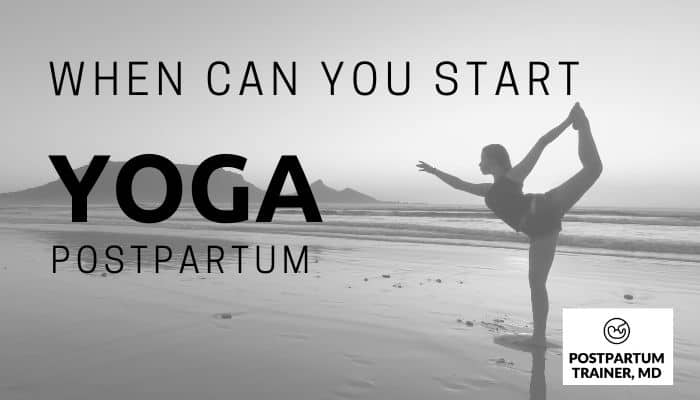
Can I Do Yoga After Having A Baby? Is It Safe?
Yes, it is safe to do yoga after having a baby. Yoga is a great way to help you stay active and start exercising in the postpartum period.
It can even help improve your mood, (which is important in the postpartum period.)
The only thing is, you shouldn’t do it right away.
When Can I Start Yoga After A Normal Delivery?
So how soon can you do yoga after giving birth?
In general, most women are encouraged to resume yoga 6 weeks after a vaginal delivery.
This may sound extreme to you, especially if you did a lot of yoga before your baby.
But it’s always best to be cautious.
With that said, every woman is different. You may feel ready to start sooner than 6 weeks.
Just make sure to ask your doctor before you make any decisions.
Can I Do Yoga After A Cesarean Delivery?
What if you had a c-section? Is yoga still safe to do?
Yes, you can do yoga even after a c-section. But, we often recommend that you wait around 8 weeks before doing it.
The reason is that yoga can put a lot of stress on your abdominal area.
It is important to remember that a c-section is major abdominal surgery. Your tissues need several weeks to heal.
As always, every woman heals differently.
If you did a lot of yoga before delivery, your body may be ready sooner. Your doctor can give you more personalized recommendations.
Precautions: What To Look Out For Before Starting
Before you start any exercise in the postpartum period, make sure that you have clearance from your provider.
In addition, you want to look out for is Diastasis Recti.
This is when your rectus abdominis muscles separate in the midline and don’t come back together as they should. Here’s how to check and see if you have diastasis recti. (Also, diastasis recti can also occur after a c-section.)
If you have a significant amount of diastasis, it’s best to avoid yoga as some poses can worsen the separation.
I have written an article on 100 exercises to improve your diastasis recti if you would like to learn more.
Okay, let’s get started.
What You Need To Start Your Postpartum Yoga Routine
Before you start your yoga routine, there are a few things you will need to have.
Here are the basics.
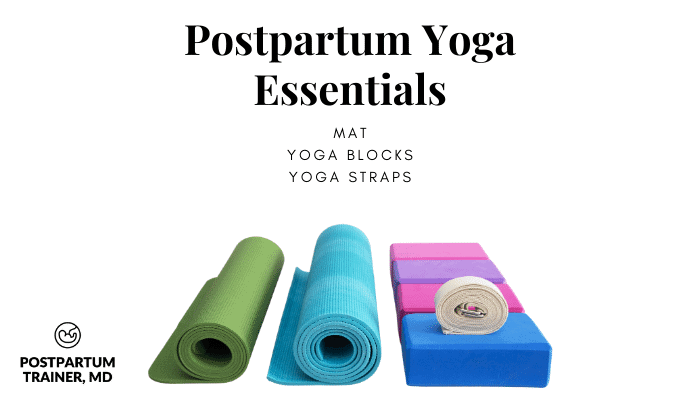
Yoga Mat
A yoga mat is a must-have. These mats are great because the material they are made of provides a lot of friction.
This means that you won’t slip when doing some of the yoga poses.
They are also really portable.
Any mat from amazon should be fine. Here’s the one I have.
Yoga Blocks
Another good tool to have is a yoga block.
These are small rectangular objects made of foam that you can use as a form of assistance.
If you can’t touch the floor when doing some of these poses, the blocks can help extend your reach.
They can also help stabilize you if you don’t have great balance.
This pair on Amazon has great reviews.
Yoga Straps
The last thing I recommend is a pair of straps.
These are useful in stretching your hamstring muscles.
Most people stretch their hamstrings by trying to bend down and touch their toes.
Others do it by sitting and reaching for their toes.
There’s a much better way!
All you have to do is lay on your back and place the strap on your foot. You can then pull on the strap and stretch your leg in different directions.
This is the one I have from Amazon.
Alright, so now let’s go over 5 easy beginner yoga poses you can do after giving birth.
5 Gentle Postpartum Yoga Poses
Okay in this section I will go over a few gentle poses that you can start with.
They don’t require a lot of strength, balance or flexibility.
Let’s start.
Child’s Pose
The first pose is the Child’s Pose.

This great pose is simple to do. First, kneel down and sit on your heels.
Then bend forward by bringing your forehead towards the ground. Raise your arms out in front of you.
Hold this position for 15-30 seconds. Take slow deep breaths, and try to allow your muscles to undergo a deep relaxation with each exhale. This pose can help stretch your lower back and your upper back muscles.
The Happy Baby Pose
Next is the happy baby pose, one of my favorite poses :).
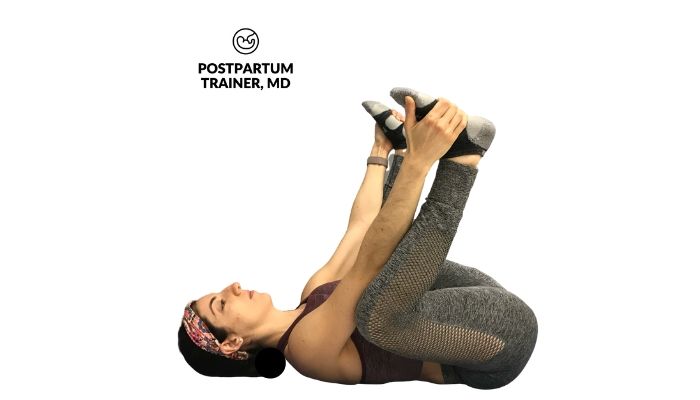
Lie on your back and bend your knees up towards your ears. Then grab the outsides of your feet to support your legs up with your feet pointing to the sky.
Open your hips as much as you comfortably can. Next, rock slowly from side to side while taking slow deep breaths.
This pose can open up your hips and relieve tension in your low back.
Hold this position for 60 seconds.
Warrior Pose
The next pose is the Warrior pose. Start by widening your stance as far as you comfortably can. Then bend your front knee while keeping your back leg straight.
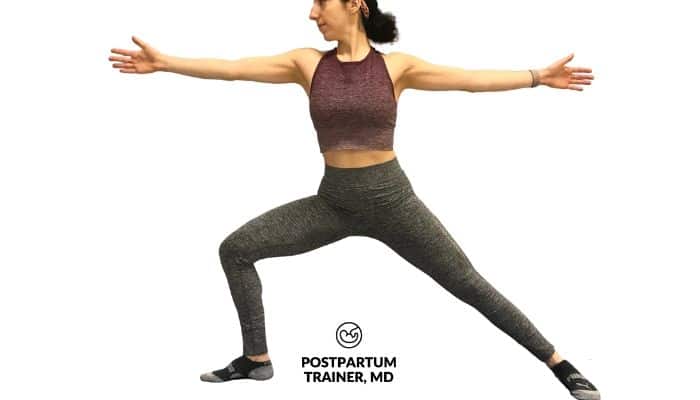
Twist your upper body slightly towards your front knee and raise your arms directly out to the side.
Lean forward to get a comfortable stretch along your back leg.
Hold this position for 15-20 seconds while taking slow deep breaths.
Switch sides and do the same on your opposite leg.
Chair Pose
The chair pose can be challenging for some. This pose will strengthen and improve the endurance of your leg muscles.
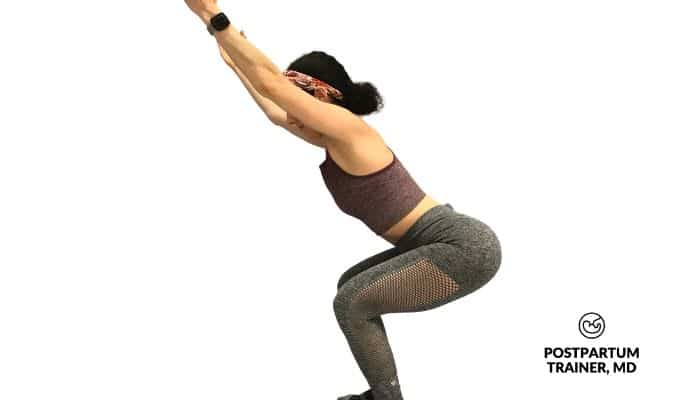
Start with your feet together and bring your arms directly over your head.
Then bend your knees to get into a semi-squat as if you were sitting in a chair.
Hold this position for 20 seconds while taking slow deep breaths.
Lying Hamstring Stretch
The last pose will stretch your hamstring muscles. I recommend that you get a yoga strap (which you can get cheaply on Amazon) to improve the range of motion you can achieve with this stretch.
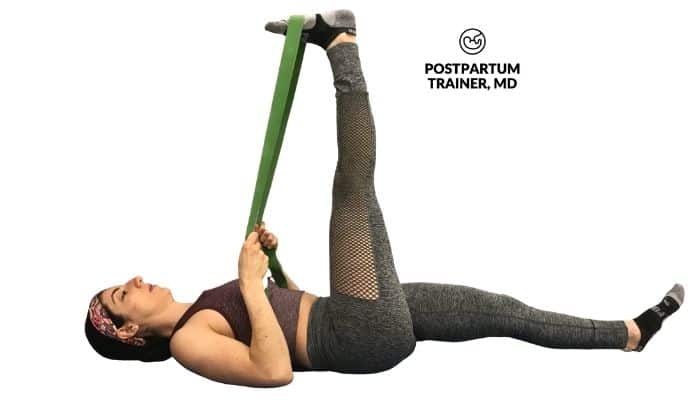
Lie on your back and place the strap across your foot. Straighten that leg and point the bottom of your foot up towards the ceiling. Use the strap to increase or decrease the stretch to your liking.
One benefit of the strap is that you can keep your back flat on the ground. That way you can concentrate on just stretching your hamstring.
Hold the stretch for 30 seconds while taking slow deep breaths.
You can even change the angle in which you pull by moving your outstretched leg out away from your body or in towards your other leg.
The PPTs Postnatal Yoga PDF
So those are the 5 movements to get your postnatal sequence started.
I recommend you do the following sequence two times. Here’s what it will look like:
| Yoga Pose | Sets | Hold Time |
|---|---|---|
| Child’s Pose | 2 | 30 sec |
| Happy Baby Pose | 2 | 60 sec |
| Warrior Pose | 2 | 20 sec per side |
| Chair Pose | 2 | 20 sec per side |
| Lying Hamstring Pose | 2 | 20 sec per side |
As you get stronger, feel free to increase the hold time as well as the number of sets.
You can do this sequence 3-4 times per week if you desire.
Yoga Poses To Avoid Postpartum
I also want to point out a few yoga poses that you might want to avoid postpartum.
At least until you are fully healed.
The poses that you should avoid are the ones that require a lot of abdominal strength.
A good example is the boat pose.
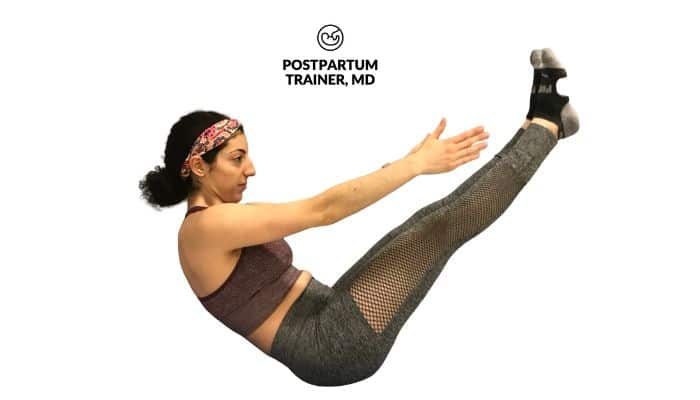
This pose can put a lot of tension on your belly, especially if you had a cesarean section.
Other poses that you might want to avoid are ones that stretch the abdomen significantly. An example is the upward dog.
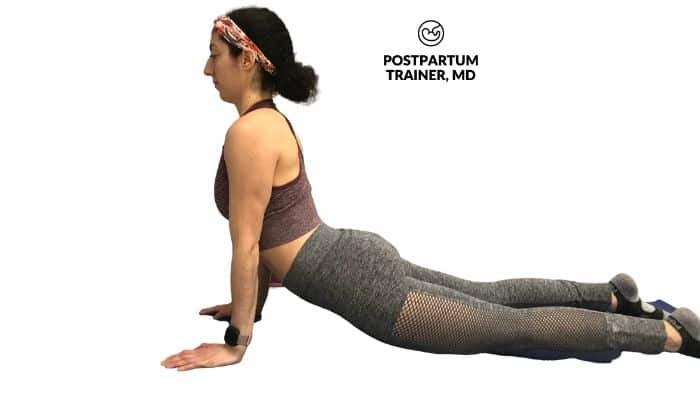
Lastly, you might want to avoid poses that require a lot of twists.
The triangle pose is a good example of an exercise you might not want to do early on.
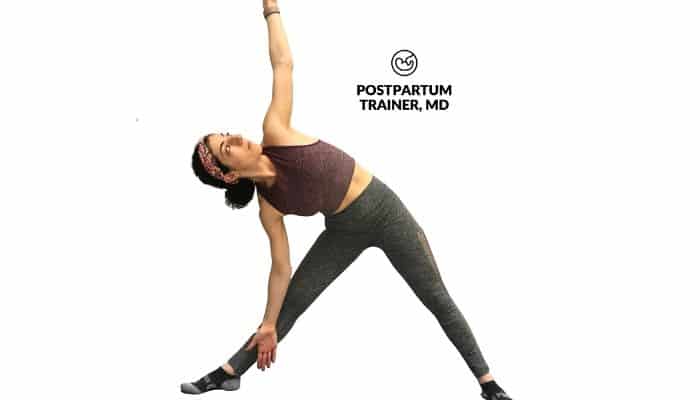
Don’t forget, these are general guidelines.
As always, if anything feels funny THEN STOP.
Don’t do any poses that cause you pain or discomfort.
The Benefits of Postpartum Yoga
In this next section, let’s go over why you should consider doing yoga in the first place.
Here are the top 4 benefits of postpartum yoga.
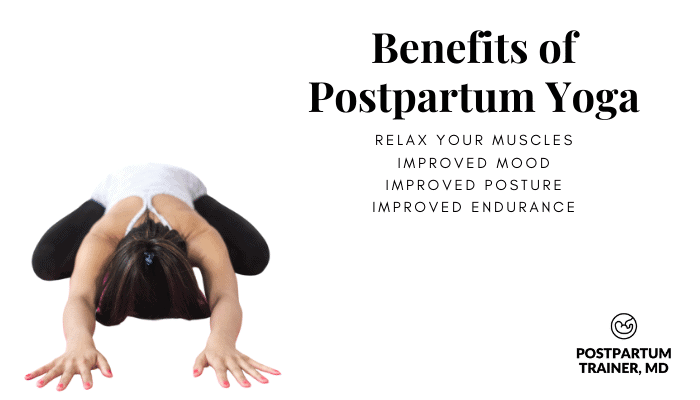
Helps Relax Your Muscles
As I’m sure you have experienced, your muscles can get sore after delivery.
You might have had an achy neck throughout pregnancy, achy shoulders or even an achy low back.
Anyone who has done yoga knows that it is a great way to stretch and relax your muscles, especially with all of the deep breathing that it requires.
Holding yoga positions can improve blood flow, aid in postpartum recovery, and strengthen the muscles in your legs, core, and shoulders.
Improved Mood
Yoga can also uplift your mood and mental health. This is especially important in the postpartum period as it can help prevent symptoms of postpartum depression.
Yoga is a lot like meditation. It forces you to be mindful of the current moment and focus on your breathing.
This is great for stress relief!
It’s also a good opportunity to do some internal reflection on yourself.
With that said, postpartum depression is a very serious condition. If you think you are experiencing symptoms of sadness, lack of interest, and apathy towards your baby, see your provider as soon as possible.
Improved posture
One of the other great benefits of yoga is better posture.
Pregnancy tends to worsen your posture in many ways. One of the most common problems postpartum women face is low back pain. I’ve written an entire article on exercises to correct low back pain postpartum.
The reason is that pregnancy shifts your weight forward, changing the natural alignment of your pelvis.
When this happens, muscles of your hips, low back, and neck can get tight.
Yoga can help release this tightness and restore your normal posture.
If you want to learn more, check out my detailed post on how to fix your posture postpartum.
Improved Endurance
Lastly, yoga can improve your muscular endurance.
Holding yoga poses is a lot of work. Your muscles will get worked!
The good news is, the more you practice, the better you’ll get. After a few weeks, your muscles won’t tire as easily.
So you’ll be able to hold the poses for longer periods of time.
Other Postpartum Yoga FAQ’s
In this last section, I will answer a couple of other basic postpartum yoga questions.
Can I Do Yoga While Breastfeeding?
Yes, you can do yoga while breastfeeding. Just don’t do them together, at the same time :).
But on a more serious note, your breasts will be full, and some positions may be uncomfortable. This is particularly true for poses where your chest is on the ground like in child’s pose.
Be sure to wear a supportive nursing bra like this one, and as always: don’t do any yoga positions that cause you discomfort.
In addition, make sure you empty your breasts before doing yoga.
I personally love using this hands free manual pump while breastfeeding my baby on the opposite breast or this portable hands free wireless pump when I want to multitask before my workout :).
While working out I also like to use these breast shells to collect any milk that happens to leak.
Is It Safe To Do Hot Yoga Postpartum?
You should be able to do hot/Bikram yoga postpartum. Start slow, and stay hydrated.
Make sure to drink plenty of electrolyte-rich fluids such as coconut water, Gatorade, or Pedialyte.
Your body will tell you what you can and cannot do.
Can I Do Surya Namaskar After Delivery?
It is probably best to avoid the 12-step sequence of the Surya Namaskar in the first few weeks after delivery as some of the poses (such as the raised arm pose, the plank position, and the cobra pose) can place too much tension on the abdominal muscles.
It is better to focus on more gentle postures at first while improving your core strength using these exercises.
Are There Any Other Safe Exercises I Can Do During My 6 Week Wait?
If you are eager to start doing some other form of activity before 6-8 weeks postpartum, here are some safe exercises you can do.
Walking
Walking is the best form of exercise. You should do it every single day for at least 10 minutes a day.
You can even start the very next day after your delivery (assuming you didn’t have any complications.)
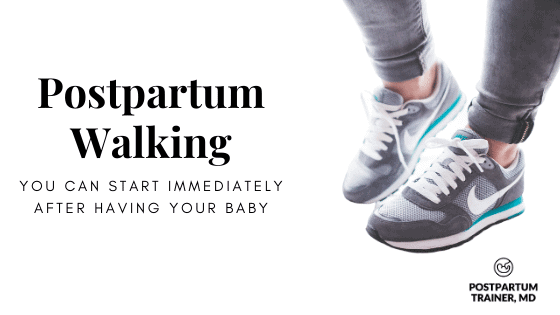
I discuss the benefits of walking in the postpartum period in my post- Getting Fit After Pregnancy.
Pelvic Floor Exercises
Another type of exercise that you can do very early after delivery is pelvic floor exercises.
You can start doing them a day or two after delivery.
The best part is, kegel exercises can be done while lying down!
Check out my post on pelvic floor muscles to learn more.
Assisted Squats
The squat is another great exercise that you could start doing ~2 weeks after delivery.
The good news is, the squat can be scaled back to make it easier.
You can always hold on to a chair for support, and you can adjust how low you go.
Keep in mind, every single time you sit and stand up, you are squatting.
I have an entire post on squatting in the postpartum period.
Rest
Lastly, don’t forget to rest. You just had a baby.
Many new moms forget that their body had to go through a lot of amazing changes throughout your pregnancy.
Give your postpartum body some time to get back into the swing of things.
Don’t be afraid to ask for help. Stay hydrated. Take naps whenever you can.
So if you can’t do yoga right away, that’s okay! Take care of yourself and your little one.
I have written on the types of exercise you can do in the early postpartum weeks in more detail here.
This should give you enough to do before you’re cleared to do yoga postures.
Final Words On When To Start A Postnatal Yoga Routine
Yoga is a great way to get back into exercising after your delivery. Don’t rush into it, and make sure your doctor says it is ok to start yoga.
Begin with basic poses, and work your way up as you get stronger.
Did you do a lot of prenatal yoga?
How many weeks postpartum are you?
Comment below and let me know!
For more information about exercising in the postpartum period, check out my Guide to Getting Fit after Pregnancy.

Related Postpartum Exercise Articles
- 100 Exercises to Rebuild Your Core Muscles
- When Can I Train My Abs Post Childbirth
- The Best Pelvic Floor Exercises to do After Having a Baby
Get Four Free Workouts To Help Strengthen Your Pelvic Floor & Heal Your Mommy Tummy!

Brittany Robles, MD, MPH, CPT
Brittany Robles is a full-time OBGYN physician, a NASM certified trainer, and a prenatal and postnatal fitness specialist. She holds a Master of Public Health degree in maternal health with a special interest in exercise and nutrition. She is also the co-author of The White Coat Trainer. Learn more about her here.
Sharing is Caring – Send This To A Mom In Need!
References:
- Lavey R, Sherman T, Mueser KT, Osborne DD, Currier M, Wolfe R. The effects of yoga on mood in psychiatric inpatients. Psychiatr Rehabil J. 2005 Spring;28(4):399-402. doi: 10.2975/28.2005.399.402. PMID: 15895926.
